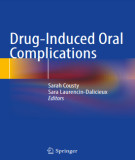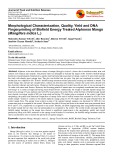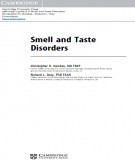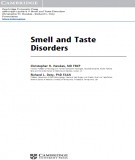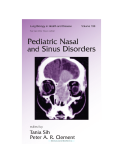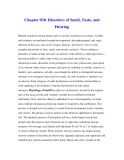
Taste disorders
-
Part 2 book "Drug induced oral complications" includes content: Drug induced oral bleeding, drug induced taste disorders, drug induced salivary gland disturbances, drug induced oral infections, drug induced facial diseases, conclusion - drug induced oral complications.
 61p
61p  muasambanhan06
muasambanhan06
 01-02-2024
01-02-2024
 3
3
 1
1
 Download
Download
-
Alphonso is the most delicious variety of mango (Mangifera indica L.) known for its excellent texture, taste, and richness with vitamins and minerals. The present study was attempted to evaluate the impact of Mr. Trivedi’s biofield energy treatment on morphological characteristics, quality, yield and molecular assessment of mango. A plot of 16 acres lands used for this study with already grown mango trees.
 6p
6p  viisac
viisac
 23-09-2023
23-09-2023
 3
3
 0
0
 Download
Download
-
Fats are regarded as crucial component of a balanced diet in dog as they help to maintain healthy skin coat, cell structure and function, including vision and learning abilities in addition to enhance taste and palatability of food. Omega-3 fatty acids are polyunsaturated fatty acids which are considered as essential fatty acids in dogs because they cannot be synthesized in the body and hence must be provided in the diet.
 11p
11p  caygaocaolon4
caygaocaolon4
 04-04-2020
04-04-2020
 24
24
 1
1
 Download
Download
-
(bq) part 1 book “smell and taste disorders” has contents: anatomy and physiology of olfaction, anatomy and physiology of gustation, measurement of olfaction, measurement of gustation.
 188p
188p  dien_vi09
dien_vi09
 13-10-2018
13-10-2018
 28
28
 2
2
 Download
Download
-
(bq) part 2 book “smell and taste disorders” has contents: non-neurodegenerative disorders of olfaction, non-neurodegenerative disorders of gustation, neurodegenerative chemosensory disorders, assessment, treatment, and medicolegal aspects of chemosensory disorders.
 0p
0p  dien_vi09
dien_vi09
 13-10-2018
13-10-2018
 26
26
 0
0
 Download
Download
-
Over the last two decades, significant progress has been made in the field of rhinology—some even feel they have been the two most exciting decades for rhinology so far. Basic research increased our knowledge of the pathophysiology of rhinosinusitis, of allergy and immunology, environmental and developmental problems, as well as of smell, taste, and genetic features. Imaging technologies with reduced or even no radiation, CT and MRI, allowed for pictures of anatomical structures and pathological processes, for three-dimensional visualization unheard of before.
 0p
0p  crius75
crius75
 04-01-2013
04-01-2013
 31
31
 1
1
 Download
Download
-
Historically speaking, the earliest asset pricing models made rel- atively simple predictions about what it means for a benchmark to be OE to a managed portfolio. The Capital Asset Pricing Model of Sharpe (CAPM, 1964) implies that all investors should hold a broadly diversified “market portfolio,” combined with safe assets or “cash,” according to the investor’s tastes for risk. It follows that an OE portfolio is a broadly diversified portfolio, combined with safe assets or cash, mixed to have the same market risk exposure, or “beta” coefficient as the fund.
 42p
42p  quaivatdo
quaivatdo
 19-11-2012
19-11-2012
 63
63
 5
5
 Download
Download
-
Related sensations during eating such as somatic sensations of coolness, warmth, and irritation are mediated through the trigeminal, glossopharyngeal, and vagal afferents in the nose, oral cavity, tongue, pharynx, and larynx. Flavor is the complex interaction of taste, smell, and somatic sensation.
 26p
26p  socolanong
socolanong
 25-04-2012
25-04-2012
 63
63
 3
3
 Download
Download
-
In the event that the hearing aid provides inadequate rehabilitation, cochlear implants may be appropriate. Criteria for implantation include severe to profound hearing loss with word recognition score ≤30% under best aided conditions. Worldwide, 20,000 deaf individuals (including 4000 children) have received cochlear implants. Cochlear implants are neural prostheses that convert sound energy to electrical energy and can be used to stimulate the auditory division of the eighth nerve directly.
 6p
6p  ongxaemnumber1
ongxaemnumber1
 29-11-2010
29-11-2010
 85
85
 5
5
 Download
Download
-
Evoked Responses Electrocochleography measures the earliest evoked potentials generated in the cochlea and the auditory nerve. Receptor potentials recorded include the cochlear microphonic, generated by the outer hair cells of the organ of Corti, and the summating potential, generated by the inner hair cells in response to sound. The whole nerve action potential representing the composite firing of the firstorder neurons can also be recorded during electrocochleography.
 5p
5p  ongxaemnumber1
ongxaemnumber1
 29-11-2010
29-11-2010
 77
77
 3
3
 Download
Download
-
Approach to the Patient: Disorders of the Sense of Hearing The goal in the evaluation of a patient with auditory complaints is to determine (1) the nature of the hearing impairment (conductive vs. sensorineural vs. mixed), (2) the severity of the impairment (mild, moderate, severe, profound), (3) the anatomy of the impairment (external ear, middle ear, inner ear, or central auditory pathway), and (4) the etiology. The history should elicit characteristics of the hearing loss, including the duration of deafness, unilateral vs. bilateral involvement, nature of onset (sudden vs.
 5p
5p  ongxaemnumber1
ongxaemnumber1
 29-11-2010
29-11-2010
 80
80
 4
4
 Download
Download
-
The responses are measured in decibels. An audiogram is a plot of intensity in decibels of hearing threshold versus frequency. A decibel (dB) is equal to 20 times the logarithm of the ratio of the sound pressure required to achieve threshold in the patient to the sound pressure required to achieve threshold in a normal hearing person. Therefore, a change of 6 dB represents doubling of sound pressure, and a change of 20 dB represents a tenfold change in sound pressure.
 5p
5p  ongxaemnumber1
ongxaemnumber1
 29-11-2010
29-11-2010
 78
78
 3
3
 Download
Download
-
Presbycusis (age-associated hearing loss) is the most common cause of sensorineural hearing loss in adults. In the early stages, it is characterized by symmetric, gentle to sharply sloping high-frequency hearing loss. With progression, the hearing loss involves all frequencies. More importantly, the hearing impairment is associated with significant loss in clarity. There is a loss of discrimination for phonemes, recruitment (abnormal growth of loudness), and particular difficulty in understanding speech in noisy environments.
 5p
5p  ongxaemnumber1
ongxaemnumber1
 29-11-2010
29-11-2010
 74
74
 4
4
 Download
Download
-
Disorders of the Sense of Hearing Hearing loss can result from disorders of the auricle, external auditory canal, middle ear, inner ear, or central auditory pathways (Fig. 30-4). In general, lesions in the auricle, external auditory canal, or middle ear cause conductive hearing losses, whereas lesions in the inner ear or eighth nerve cause sensorineural hearing losses. Figure 30-4 An algorithm for the approach to hearing loss.
 5p
5p  ongxaemnumber1
ongxaemnumber1
 29-11-2010
29-11-2010
 75
75
 3
3
 Download
Download
-
The contribution of genetics to presbycusis (see below) is also becoming better understood. In addition to GJB2, several other nonsyndromic genes are associated with hearing loss that progresses with age. Sensitivity to aminoglycoside ototoxicity can be maternally transmitted through a mitochondrial mutation. Susceptibility to noise-induced hearing loss may also be genetically determined. There are 400 syndromic forms of hearing loss.
 5p
5p  ongxaemnumber1
ongxaemnumber1
 29-11-2010
29-11-2010
 55
55
 4
4
 Download
Download
-
Ear anatomy. A. Drawing of modified coronal section through external ear and temporal bone, with structures of the middle and inner ear demonstrated. B. High-resolution view of inner ear. Stereocilia of the hair cells of the organ of Corti, which rests on the basilar membrane, are in contact with the tectorial membrane and are deformed by the traveling wave. A point of maximal displacement of the basilar membrane is determined by the frequency of the stimulating tone. High-frequency tones cause maximal displacement of the basilar membrane near the base of the cochlea.
 9p
9p  ongxaemnumber1
ongxaemnumber1
 29-11-2010
29-11-2010
 73
73
 4
4
 Download
Download
-
Disorders of the Sense of Taste Disorders of the sense of taste are caused by conditions that interfere with the access of the tastant to the receptor cells in the taste bud (transport loss), injure receptor cells (sensory loss), or damage gustatory afferent nerves and central gustatory pathways (neural loss) (Table 30-2). Transport gustatory losses result from xerostomia due to many causes, including Sjögren's syndrome, radiation therapy, heavy-metal intoxication, and bacterial colonization of the taste pore.
 5p
5p  ongxaemnumber1
ongxaemnumber1
 29-11-2010
29-11-2010
 70
70
 5
5
 Download
Download
-
Approach to the Patient: Disorders of the Sense of Taste Patients who complain of loss of taste should be evaluated for both gustatory and olfactory function. Clinical assessment of taste is not as well developed or standardized as that of smell. The first step is to perform suprathreshold whole-mouth taste testing for quality, intensity, and pleasantness perception of four taste qualities: sweet, salty, sour, and bitter. Most commonly used reagents for taste testing are sucrose, citric acid or hydrochloric acid, caffeine or quinine (sulfate or hydrochloride), and sodium chloride.
 5p
5p  ongxaemnumber1
ongxaemnumber1
 29-11-2010
29-11-2010
 73
73
 3
3
 Download
Download
-
Definitions Disturbances of the sense of taste may be categorized as total ageusia, total absence of gustatory function or inability to detect the qualities of sweet, salt, bitter, or sour; partial ageusia, ability to detect some but not all of the qualitative gustatory sensations; specific ageusia, inability to detect the taste quality of certain substances; total hypogeusia, decreased sensitivity to all tastants; partial hypogeusia, decreased sensitivity to some tastants; and dysgeusia or phantogeusia, distortion in the perception of a tastant, i.e.
 6p
6p  ongxaemnumber1
ongxaemnumber1
 29-11-2010
29-11-2010
 73
73
 3
3
 Download
Download
-
Disorders of the Sense of Smell These are caused by conditions that interfere with the access of the odorant to the olfactory neuroepithelium (transport loss), injure the receptor region (sensory loss), or damage central olfactory pathways (neural loss). Currently no clinical tests exist to differentiate these different types of olfactory losses. Fortunately, the history of the disease provides important clues to the cause.
 5p
5p  ongxaemnumber1
ongxaemnumber1
 29-11-2010
29-11-2010
 80
80
 3
3
 Download
Download
CHỦ ĐỀ BẠN MUỐN TÌM








